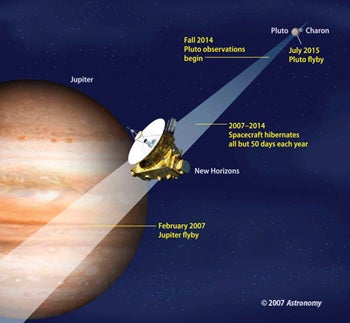
More resources from Astronomy magazine:
Astronomy news
This week’s sky events
Astronomy basics
Glossary of astronomical terms
Return to Astronomy “For the media” page
Astronomy promotes the science and hobby of astronomy through high-quality publications that engage, inform, entertain, and inspire. Jupiter science
As a bonus, the modern instruments aboard New Horizons will map Jupiter’s largest moons more comprehensively and in greater detail than did NASA’s Galileo orbiter, which studied the planet between 1995 and 2003. Jupiter’s large moons include Io, the solar system’s most volcanic body, and Europa, which may harbor a global ocean beneath its icy shell.
The probe’s seven instruments are also studying Jupiter’s turbulent atmosphere, which underwent significant change in 2006. Well known for sporting a centuries-old Great Red Spot big enough to swallow Earth, Jupiter developed a second, smaller red spot – nicknamed “Red, Junior” – when a white-oval storm system apparently intensified.
Plans call for New Horizons to return data about Jupiter until mid-June. “After that, our team begins testing hibernation techniques New Horizons will need for its long journey,” Stern notes. Hibernation reduces wear on many of the spacecraft’s instruments by turning them off most of the time.
“You won’t hear much from New Horizons between 2008 and late 2014, but don’t forget us,” Stern concludes. “In early 2015, the curtain rises on the first-ever Pluto encounter.”
Job one
The Jupiter flyby’s first and foremost objective is “to thread the orbital needle,” Stern explains, and place New Horizons at the Pluto aim point February 28, 2007 – 1.4 million miles (2.3 million kilometers) to Jupiter’s right as we see it from Earth. This is about 10 times farther than Voyager 1’s 1980 flyby, but more than 3 times closer than NASA’s Cassini probe, which in December 2000 used a Jupiter flyby to shorten its trip to Saturn. At closest approach, New Horizons sees Jupiter looming 3.5° across in the sky – about 7 times bigger than the Full Moon seen from Earth.
New Horizons must hit its Pluto aim point within about a minute of its target time and with an accuracy of 900 miles (1,500 km). “Missing either requirement would be costly, forcing the craft to use most of its precious fuel after the Jupiter encounter to trim its Pluto trajectory,” Stern says.
The team’s second goal at Jupiter is to put New Horizons and its instruments through their paces, shaking out bugs or unexpected behaviors at Jupiter, rather than at Pluto. “We want to learn as much as possible about our spacecraft at Jupiter so we learn only about Pluto at Pluto,” Stern explains. “So, at Jupiter, we plan to track and image multiple moving targets, run multiple instruments at the same time, fill the solid-state memory with even more data than we’ll collect at Pluto, and much more.”
February 21, 2007
WAUKESHA, WI – NASA’s New Horizons mission to Pluto, launched just last year, is already flying past Jupiter, the solar system’s largest planet.
(Visit New Horizons’ web site.)
“New Horizons’ 13-month journey from Earth to Jupiter sets a new speed record,” says S. Alan Stern, the mission’s lead researcher, in the April 2007 issue of Astronomy. “It shaves 3 months off the previous record.”
Although New Horizons won’t reach Pluto for another 8 years, the Jupiter encounter – and the increased speed that comes with it – is the only reason the probe will reach its target this fast. The giant planet boosts New Horizons’ speed by approximately 9,000 mph (14,500 km/h).
“That’s half the speed of a space shuttle in Earth orbit – essentially for free,” Stern says in Astronomy‘s exclusive New Horizons update.
Comprehensive coverage of New Horizons’ mission from Astronomy.com and Astronomy magazine
- Astronomy.com exclusive: New Horizons’ principal investigator, S. Alan Stern, blogs about this historic mission.
- “New Horizons flies past Jupiter” – This six-page preview of the spacecraft’s Jupiter encounter appears in the April 2007 Astronomy magazine, which hits newsstands March 3, 2007. Click here for a PDF of the article’s opening spread.
- Both Astronomy.com and Astronomy magazine will provide indepth coverage and regular updates of New Horizons’ epic mission.









